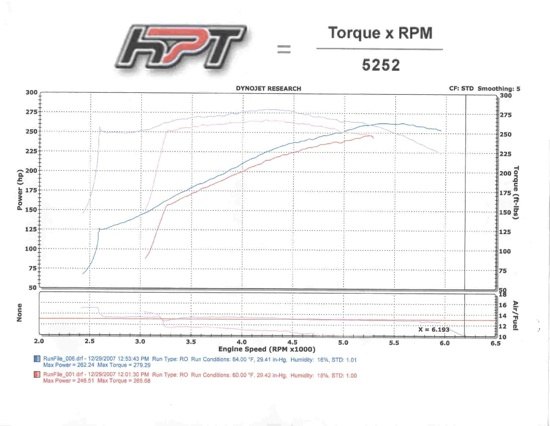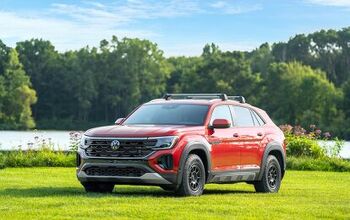Product Review: SCT Dyno Tuner

Before the days of anti-smog legislation and catalytic converters, anyone looking for more power in their ride needed a few tools, access to a drag strip and intimate knowledge of their carburetor. This concept lives on today, but the names and faces changed: Hot-Rodders are now Tuners. Here’s an idea: let’s see how much power is left on the table after a Tuner gets their hands on a fuel-injected, late-model performance machine. But first a word from our hacker . . .
SCT is one of the larger software and support providers. Their work is suitable for a farrago of fuel-injected American vehicles. Their plug-and-play tuners for 1996 and newer vehicles is ideal for your average horsepower junky seeking a quick fix. Custom packages installed on your race-ready laptop are also yours for the asking. Between these options lies a one shot, custom-tune performed by an SCT licensed dyno tuner specifically for your vehicle. Bingo.
My dyno shop of choice: Henderson Performance Technologies in New Braunfels, TX. The owner, Corey Henderson, offers a wide selection of SCT products, two dynos, a clean shop, years of EFI tuning know-how and a Mechanical Engineering degree. Safe!
TTAC’s test car: a Lincoln Mark VIII LSC. Originally, the American whip’s V8 made 290 hp and 290 lb·ft of torque at the flywheel. That equates to 232/232 at the rear wheels, using the universally accepted 20 percent drive train loss calculation for rear wheel-drive vehicles running automatic transmissions.
And then I started wrenching. I gutted a junkyard Lincoln’s (already large) mass-airflow sensor with a Dremel. I also installed headers with a mandrel bent 2.5″ diameter dual exhaust. Because FoMoCo’s factory tuning on the Mark VIII’s 32-valve 4.6L V8 was unbelievably fuel heavy and conservative, especially compared to its Mustang Cobra cousin, my shade tree tuning made the Mark VIII feel much faster than stock. I was about to find out by how much.
The baseline dyno pull was first on the agenda. I handed the keys to Corey Henderson, who strapped the big Lincoln on the dyno and spun the rollers. Nothing. Corey dug deep into SCT’s adjustable parameters to lock the transmission into third gear. (A 1:1 transmission ratio is required to accurately measure power to the wheels.) With that hiccup cleared, the Mark VIII managed a respectable 246 hp and 265 lb·ft of torque. That’s a respectable increase, considering the modifications performed are the logical start for almost every late model performance car.
And then we got stuck in, messing around with the (previously untouched) computer. Corey downloaded SCT’s base tune for the Mark VIII, attacking the factory’s air-fuel ratio to remove the lean-to-rich behavior at full throttle. The following dyno pull achieved a peak of 262 hp and 279 lb·ft of torque. More importantly, the Lincoln gained an astounding 20 lb·ft of torque below 3500 rpm. Adding that much twist with an automatic transmission in the way is pretty impressive stuff.
Like any good dyno tuner, Corey started on the ignition curves. He added one degree of ignition timing; the Mark VIII lost one horsepower. Too bad about that, so the previous tune was set in stone. [click to expand]
Actually, no. SCT tunes include engine and transmission tuning at high and low throttle inputs, cooling fan settings and a blizzard of engine parameters wholly unnecessary for this nearly stock application. Corey kicked in the cooling fans at a lower temperature and adjusted the transmission’s internal “line pressure” to eliminate the soft, lazy up shifts, which makes sense at full throttle, but that’s no small feat for low speed shifting with an aftermarket 2800-stall torque converter.
The end result? Anticlimactic: the Lincoln’s new programming feels slower, since the power curve is both fatter and more linear. But that’s a good thing. While originally engineered for 91 octane gas, the Mark VIII now exploits 93 octane, but still runs effortlessly on regular (87 octane) fuel. The aforementioned increase in low-end torque means top gear passing requires less throttle input, while the transmission’s programming overcomes the drag-strip worthy converter for stock levels of fuel economy, even in rev-inducing bumper to bumper traffic.
Considering the Mark Series of the 1970s had flat, torque-rich power bands and Cadillac-killing swiftness in their transmissions, perhaps SCT made my Mark VIII more of a Lincoln and less of a MK-Zephyr. Color me impressed.
If you’re thinking that SCT covers all the bases, you’re only partially right. On the Internet or near the Interstate, there are SCT approved Tuner Shops aplenty. But they aren’t equal: a human is still responsible for SCT’s actions. Take the plunge without fear, but check your model-specific car forum for the right questions to ask a shop. Pick your Tuner wisely for the most bang for your buck.
[ Henderson Performance Technologies provided their Dyno Tuning services at a discount.]

More by Sajeev Mehta
Latest Car Reviews
Read moreLatest Product Reviews
Read moreRecent Comments
- FreedMike Um, OK. EVs are just cars, folks. I have no idea why they take up so much rent-free space in some folks' heads.
- Analoggrotto *What's the most famous track you have driven on while Hyundai foots the bill?
- 2ACL I'm pretty sure you've done at least one tC for UCOTD, Tim. I want to say that you've also done a first-gen xB. . .It's my idea of an urban trucklet, though the 2.4 is a potential oil burner. Would been interested in learning why it was totaled and why someone decided to save it.
- Akear You know I meant stock. Don't type when driving.
- JMII I may just be one person my wife's next vehicle (in 1 or 2 years) will likely be an EV. My brother just got a Tesla Model Y that he describes as a perfectly suitable "appliance". And before lumping us into some category take note I daily drive a 6.2l V8 manual RWD vehicle and my brother's other vehicles are two Porsches, one of which is a dedicated track car. I use the best tool for the job, and for most driving tasks an EV would checks all the boxes. Of course I'm not trying to tow my boat or drive two states away using one because that wouldn't be a good fit for the technology.



































Comments
Join the conversation
No argument here.
Are you considering testing multiple SCT tunes in the future to measure the benefits at different settings? They offer some nice touch screen models now that offer some unique tuning capabilities. It's nice to see the dyno breakdown like this.